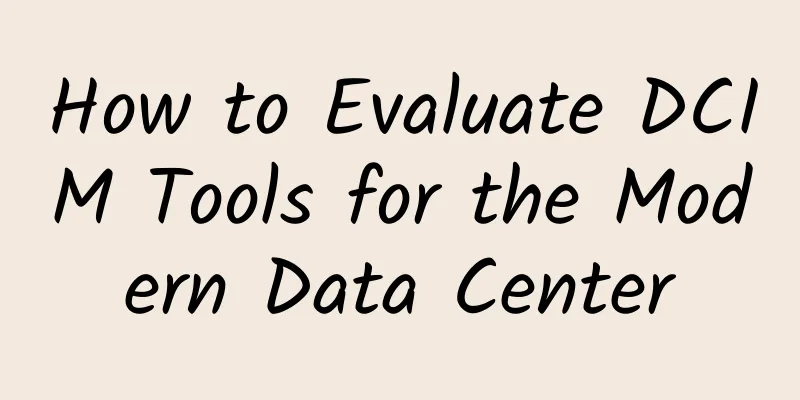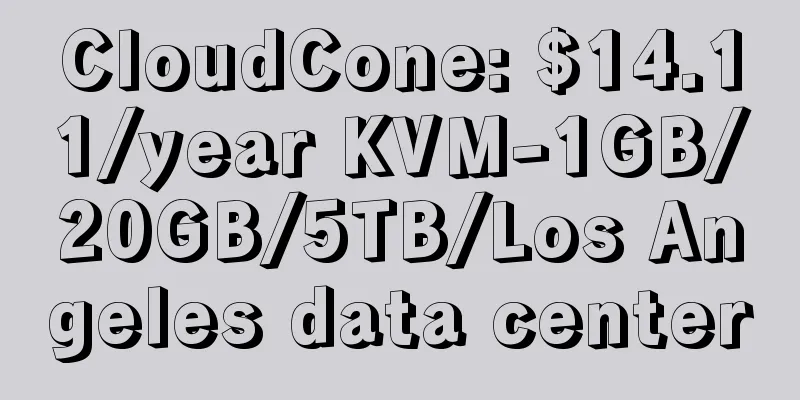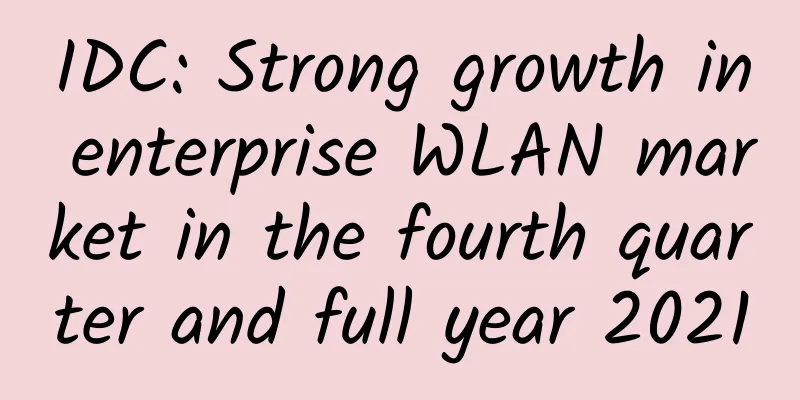How to Evaluate DCIM Tools for the Modern Data Center

|
There are almost too many data center infrastructure management (DCIM) tools on the market today to count. Your data center will need a methodology for evaluating these tools to ensure you are able to keep up with and take full advantage of the trends in the modern data center. In this article, we will introduce effective solutions to help you evaluate DCIM tools to help your company make full use of system data for actionable insight analysis, and introduce you to the DCIM evaluation process in detailed steps. As with any software package, data center infrastructure management (DCIM) tools are available in a range of options, and the user-programmable settings are almost limitless. Enterprise buyers should first understand their own business needs and how to analyze potential tools on the market to see if they can meet those needs. The ultimate measure of a good DCIM software platform is how easily your enterprise can get the information it needs from the vast amount of system data collected by the selected tool. Asset Tracking and Management All DCIM systems allow administrators to transfer data from existing Excel spreadsheets to the DCIM database. If you need to maintain new systems manually, your chosen DCIM software must be intuitive and provide enough detail for your staff to easily enter that level of detail. The DCIM tool vendor's instructions will instruct you on how to import the actual data from the spreadsheet so that you can manipulate the data yourself and understand what maintenance involves. An effective DCIM tool should be able to show you what equipment your data center has and what cabinets and rack spaces it is housed in. This update can be semi-automated by placing barcode labels on the equipment and scanning them manually. However, in large operations, even this level of manual maintenance may be too time-consuming. In this case, you can consider automating tracking through the use of RFID tags or other in-rack sensing methods. This is an advanced feature that requires additional costs to tag each piece of hardware, but this method can save operations staff a lot of time and ensure that the database data is up to date and 100% accurate. Regardless of the update method, detailed asset tracking should provide more than just a tabular list. Rack height may also be a premium feature of some DCIM products. Consider that future upgrades may also enable asset tracking capabilities to perform a wider range of tasks, such as real-time and projected power resource usage. Network and Compute Optimization This is probably the most complex task that DCIM software can provide, but for many enterprise data centers, it is the most important. Some systems even focus on this function and do nothing else. If your main priority is to optimize computing resources and network performance, and maintain maximum network reliability, then be sure to investigate the level of analysis that these specialized systems can provide that is not available in more extensive DCIM products. This may mean that other functions, such as asset tracking and energy monitoring, will require a second form of DCIM software, but the lack of integration may be offset by the operational improvements provided by a system dedicated to network optimization. On the other hand, a fully integrated package may provide all the performance analytics you need for your enterprise data center. For enterprise IT professionals, evaluating the network and compute optimization capabilities of potential DCIM software will be more familiar and handy than evaluating IT and power and cooling solutions. However, as with any DCIM tool, overbuying more than your business really needs and can utilize can result in a costly, complex and underutilized system. Power and cooling optimization Before purchasing a DCIM package, be sure to confirm the compatibility of the potential DCIM package with the communication protocols you already have in your data center. In particular, many mechanical devices are not IP addressable. The most common platforms for these systems are Modbus and BACnet. Check with your data center's engineering or facilities department to determine the protocols required to complete the necessary monitoring. Gas flow and temperature monitoring may be quite important to the facility, but sensors for these measurements will need to be added by other systems. Even smart rack PDUs that offer IP interfaces will have different encoding schemes. Ensure compatibility of the DCIM software with the brand and type of equipment used in your data center, or if the vendor will charge additional fees if your data center needs to develop the software interface. The most important thing to consider when choosing the capabilities of your power and cooling monitoring software is the results of monitoring these physical parameters of your data center. Fault alerts are obviously important, but the system you choose should allow you to easily distinguish between major and minor fault alert events. Historical data is even more important because the historical data your company stores can show when and where problems started, helping to avoid recurrence. The greater value of this historical data is in predictive software that can analyze trends and alert you to impending disasters before they occur. Real-time reporting and analytics Before putting equipment into operation, especially in high-density environments, it can save a lot of trouble to assess how the installation of new hardware will affect the data center's power equipment, cooling equipment, rack space, computing performance, and so on. This assessment can take many forms. Most DCIM products include an equipment database that quantifies physical size and estimates characteristics such as power consumption, thermal load, and network connectivity. Some systems can even track rack weight and floor loading, and can update power consumption over time based on actual measurements. What-if analysis allows you to pinpoint potential locations for new hardware and see the impact of installing equipment on power and cooling before you install it. This information can be displayed in a tabular view, and some systems will even prioritize several locations based on a number of key parameters. Graphical displays can make this information easier to understand. The most powerful systems can even display equipment locations in 3D. For high-density enterprise data centers, what-if analysis can be used to assess the impact of installing new hardware on data center power and cooling when there is excess rack space but the operating environment does not support it. However, while real-time reporting can be a useful feature in a demonstration, you may already be well on your way when you have fully integrated the other features needed to support it. Purchasing Options How you actually handle the financial aspects of implementing a DCIM tool is often determined by your CFO. Some companies prefer to focus on operating costs (OpEx) rather than capital expenditures (CapEx). Some DCIM vendors offer their software as a one-time purchase with annual maintenance fees. Others offer subscription services, service terms, or licensing options. Some products have SaaS licenses, while others offer outright purchases on a pay-as-you-go basis. Some vendors offer a basic package on a 14-day free trial, so you can actually try it out before making a larger commitment. Typically, vendors price their DCIM products based on the number of racks or devices the software must manage (and include specific monitoring modules). Vendors typically offer software maintenance and updates with annual licenses or maintenance fees. All vendors offer online demos of their products. Some of these demos can be completed in an hour or less, while others may take a little longer to get a full picture of the features. It is worthwhile to take the time to review the products of several potential vendors before narrowing your considerations and making a final purchase. Each vendor's demo will give you more features and details to compare with its competitors. DCIM use and maintenance Ease of use and the time required to maintain it is actually inversely proportional to the complexity of the DCIM product, so this is an important aspect of DCIM product evaluation. Spend some time researching your top two or three products to really understand the differences between them and ultimately decide on the best option for your company. The best technology product may be great for complex operations, but not great for your personnel. You should have multiple people involved in the evaluation. Crisis situations rarely occur when the best trained people are involved, so be sure to have enough staff at the right level to access your DCIM software suite and track and figure out what they are supposed to do. DCIM Tools and Their Place in the Modern Data Center As current data center management becomes more and more complex, data center administrators are forced to seek corresponding DCIM tools to better manage disaster prevention, capacity planning, and assets and energy consumption. A DCIM tool can be used to manage all aspects of a data center, covering everything from power and cooling optimization to power usage efficiency tracking to data center asset and cable management. But how necessary is DCIM to accomplish all these things? A common belief in the data center industry is that a DCIM tool is only suitable for large enterprise organizations whose operations are too complex to manage manually. The necessity of a data center infrastructure management (DCIM) platform depends on how data center managers run their operations; how concerned they are about the reliability of their infrastructure equipment; and whether they can operate more efficiently with good management information that is easily accessible. There is an implementation period and a learning curve, so enterprise buyers must be clear about the real reasons why their organization should consider adopting DCIM tools. Disaster Preparedness Disaster prevention is probably the biggest reason why enterprise buyers are seriously considering adopting DCIM tools. This often happens when an organization feels that it is too close to encountering a catastrophic event or the company does not want to repeat the real disaster failure it has experienced in the past. The ability to see a holistic view of data center operations through a single pane of glass, with access to historical alarms, events and automatic failover, is an invaluable tool for maintaining data center operations, managing service level agreements and enabling rapid recovery when problems occur. Taking a close look at DCIM is like checking the weather forecast to predict the likelihood of a storm - looking at it in itself may not completely prevent a problem from happening, but being able to predict when a disaster might occur will go a long way in helping the organization better prepare for it. asset Management Servers, storage, power and cooling equipment are all expensive, and the budget for purchasing these equipment is always strictly limited. Data center managers must understand the relevant assets currently owned by the enterprise data center, where they are located, and how they are running, so as to maximize cost-effectiveness. When you use a static infrastructure management platform to track assets, your data center may encounter irrelevant and outdated information. Dynamic asset management attached to a workflow system ensures that if inventory changes or migrates, it is automatically updated in the configuration management database to ensure that all data is relevant and accurate. For example, if you update an Excel spreadsheet in your data center, you may forget to update the information in other databases. A strong DCIM asset manager can select the brand, model, network ID, configuration, operating system version, installed applications, cable connection status and physical properties such as size, weight, voltage, connector type and expected power of the tool. It can also include location identification, power monitoring and cable connections presented in database and graphical formats. Improve data center capacity planning Once your data center assets are well controlled, you should be able to examine the potential impact of changes before they are implemented. If you are unsure how much power or cooling capacity is still available in a given cabinet, you should confirm this before installing new hardware and putting it into service. Likewise, don’t buy new hardware with idle compute or storage capacity, which is not only a waste of budget but also a waste of energy. Since human error remains the single largest cause of failure in data centers, a system like this helps manage and provides detailed tracking details of actions, adds, and changes, which can significantly reduce the risk in this area. Manage and monitor energy costs The energy costs of a data center far exceed the cost of the hardware equipment during its service life. Therefore, reducing energy consumption as much as possible in an enterprise data center is responsible for the environment, but more importantly, the biggest reason to save energy is to reduce costs. A DCIM tool can help an enterprise data center maximize performance and minimize the risk of failures, while providing the relevant information needed to monitor and improve energy use. Don't overbuy and don't expect to solve all your problems once and for all by overbuying a DCIM tool. You need to prepare in advance, properly train the relevant personnel in your enterprise data center, and make the most of this important investment. One of the most difficult parts of DCIM deployment in an enterprise data center comes from the resistance of old management systems to change. Simply doing things in a different way or getting different teams such as IT and facilities to agree is undoubtedly a challenge. Everyone has different understandings and opinions on the priorities for implementing data center monitoring and reporting, but the debate itself can reveal the problems that DCIM tools can help data center operations and personnel solve. In fact, the existence of a DCIM tool and the communication required to deploy it across departments can help bridge the gap that often exists between IT and facilities teams. With a mature DCIM platform, both the IT and facilities teams of an enterprise organization can better understand what information is more important to each other. The ability of the two entities to view information in a common system can significantly shorten the reaction time and correction time. About DCIM deployment and implementation DCIM tools can be a very valuable management tool within an enterprise data center. However, like any implementation, if management has overly ambitious goals, unrealistic expectations, or a lack of preparation, then the implementation will fail. Generally speaking, it takes a few weeks to deploy an entry-level toolkit, depending on the size of your data center and the complexity of the DCIM product you choose. Be sure to set aside some preparation time before you start the actual transformation of your data center. Almost every aspect of a data center's operations can be improved by properly implementing DCIM. Monitoring is critical to achieving reliability and efficiency. Regardless of your data center's specific practices, it should be a regular part of your data center's daily operations and management. A mature DCIM suite can help your organization better achieve this goal. |
<<: What are the big opportunities after NB-IOT in the field of Internet of Things?
Recommend
The “long and short” debate on WeChat video accounts
[[345275]] During the National Day holiday, WeCha...
EU plans to develop regulatory "blacklist" Facebook and Apple may be on the list
It is said that the EU's move is aimed at lim...
The three kings of wireless communications, who can manage tens of billions of IoT devices?
According to the "2018-2023 China Internet o...
CloudCone: CDN promotion starts at $4.5/year, including nodes in Hong Kong/Taiwan/Vietnam/Japan/USA
In March this year, the blog shared the informati...
Do enterprise networks need to be upgraded to IPv6? What preparations should be made?
After decades of development and application, the...
Connecting cloud, data and intelligence, Inspur Network aims to build a fully connected network based on business in 2018
[51CTO.com original article] On August 29, the tw...
For the first time in 21 years! SpaceX acquires satellite communications startup
On August 9, according to foreign media reports, ...
5G development has entered a critical period, and the following major applications are worth paying attention to in 2021
Since its official commercial launch in 2019, aft...
RAKsmart: Cloud servers starting from $1.99/month, VPS hosting starting from $0.99/month, data centers in Hong Kong/Japan/Singapore/Korea/USA
RAKsmart is a hosting company founded by overseas...
Case Study | Ruishu Information helps a large online payment company upgrade its marketing value
The operation team of a large online payment comp...
What to expect from SD-WAN in 2019? Five major trends to watch
There’s probably no hotter topic in networking ci...
[Christmas] ColoCrossing 35% off: $2.57/month-1GB/25G SSD/20TB@1Gbps/Los Angeles & New York Data Center
I just shared the news of ColoCrossing's 25% ...
[Black Friday] Hostodo: $13.99/year-512MB/16G NVMe/3TB/Las Vegas & Spokane & Miami Data Center
Hostodo's Black Friday promotion this year is...
Knowledge graph, a new choice for getting rich quickly oO!
Let it be X first, and then according to the Pyth...
What exactly is 5G security and why is it important?
New technologies always bring with them a lot of ...









